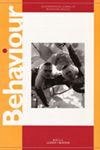Intersexual differences in the exploratory behaviour of blue tits (Cyanistes caeruleus)
IF 1.2
4区 生物学
Q4 BEHAVIORAL SCIENCES
引用次数: 0
Abstract
Breeding performance and survival are mechanisms through which animal personality affects fitness. Exploration behaviour (EB) is an easily obtainable personality trait that correlates to multiple life-history traits, thus it has been widely used in animal personality studies. Through in situ Novel Environment exploration tests, we assessed the exploration behaviour of blue tits (Cyanistes caeruleus) during two breeding seasons. A principal component analysis revealed two behavioural axes regarding the exploration behaviour: slow-fast and timid-daring. We found that male blue tits are significantly slower explorers than female blue tits, suggesting that evolutionary processes act unequally across sexes in our study area. To investigate these processes, we assessed the relationship between exploration behaviour and two fitness aspects: reproduction and survival. Slower-exploring males bred in nests with significantly shorter incubation periods, and timid males had higher local return ratios. Interactions between male and female EB revealed that disassortative pairs were more successful breeders than assortative ones. Further research should explore potential evolutionary implications of intersexual EB differences.蓝山雀(蓝山雀)探索行为的两性差异
繁殖性能和生存是动物个性影响健康的机制。探索行为(EB)是一种容易获得的人格特征,与多种生活史特征相关,因此在动物人格研究中得到了广泛应用。通过原位新环境探索试验,我们评估了蓝山雀(蓝山雀)在两个繁殖季节的探索行为。主成分分析揭示了探索行为的两个行为轴:缓慢-快速和胆小-大胆。我们发现,雄性蓝山雀的探索者速度明显慢于雌性蓝山雀,这表明在我们的研究领域,不同性别的进化过程是不平等的。为了研究这些过程,我们评估了探索行为与生殖和生存这两个健身方面之间的关系。在孵化期明显更短的巢穴中繁殖的探索速度较慢的雄性,胆小的雄性具有更高的局部回报率。雄性和雌性EB之间的相互作用表明,分离配对比分类配对更成功。进一步的研究应该探索双性EB差异的潜在进化意义。
本文章由计算机程序翻译,如有差异,请以英文原文为准。
求助全文
约1分钟内获得全文
求助全文
来源期刊

Behaviour
生物-动物学
CiteScore
1.80
自引率
7.70%
发文量
44
审稿时长
3 months
期刊介绍:
Behaviour is interested in all aspects of animal (including human) behaviour, from ecology and physiology to learning, cognition, and neuroscience. Evolutionary approaches, which concern themselves with the advantages of behaviour or capacities for the organism and its reproduction, receive much attention both at a theoretical level and as it relates to specific behavior.
 求助内容:
求助内容: 应助结果提醒方式:
应助结果提醒方式:


